The past year has seen a lot of innovations in the 360° video industry and sound is one of them. In this article, I share my thoughts about the new spatial/ambisonic audio microphones that have hit the market recently and how they compare to the earlier generation.
On the one side, we have the Røde NT-SF1 that is challenging the Sennheiser Ambeo VR mic. On the other side, we have the Zoom H3-VR as the long-awaited update for Zoom’s H2n handheld field recorder. I won’t be going into the details and spec differences of all these microphones because those are available on thousands of other websites. I will, however, look at the self-noise of these mics because this is something that is very important for us since we predominantly film 360° nature and relaxation videos for our Atmosphaeres 360° Stock Videos and VR Experiences. Also, I used to record nature sounds professionally with a matched pair of Røde NT5 microphones, so naturally, when Røde announced the NT-SF1, I was very interested to compare the self-noise of the NT-SF1 with that of the other spatial audio microphones. Full disclosure, the kind folks at Røde and Zoom sent us a loan unit of the NT-SF1 and the H3-VR (respectively), however, I guarantee that my impressions are 100% honest, which is also what Røde and Zoom requested from me. So this is the
Setup
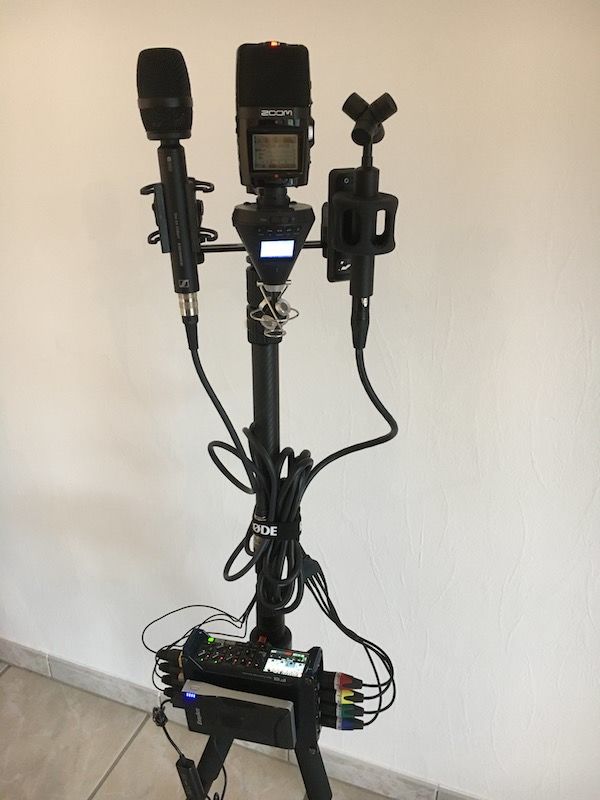
On the left we have the Ambeo, followed by the H2n in the top middle, the H3-VR bottom-middle (inverted) and the NT-SF1 on the right. The Ambeo and NT-SF1 were recorded on a Zoom F8 field recorder with channels 1-4 used by the NT-SF1 and channels 5-8 used by the Ambeo. Before anyone asks, yes, I use a USB powerbank with a 12V to 5V converter to power the F8 and yes, I have heard all the arguments for and against it. I have never had any issues with this setup, so I will continue to use it. Below is a close-up of the test setup with a little more detail.
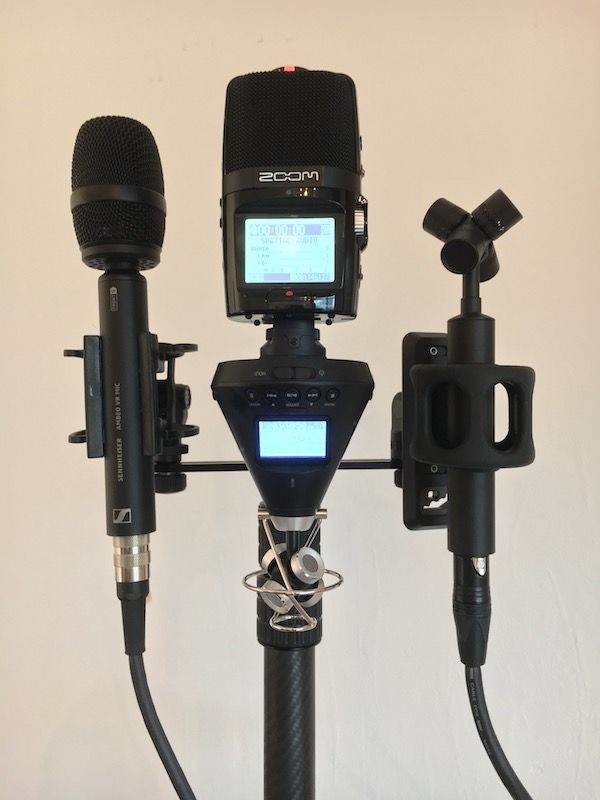
Recording
I put the rig inside a central room in our house that is built from solid bricks and has no windows, so it is a very quiet location. All recorders were set to 24bit/48KHz with low cut filters turned off. I set the gain to 35 on the F8, 8 on the scale of the H2n and 55 on the scale of the H3, which was a medium level on all recorders so the sound would not clip when I snipped my fingers. At the beginning of the recording, I summarise what I have written up until here and then I leave the room and close the door. At this point, you will hear about 25 seconds of recorded silence from each of the microphones (see below for the files). Afterwards, I come back into the room and finish the recording. Really not much, right? And honestly, the results do not come as a great surprise (spoiler: the Røde NT-SF1 and Zoom H3-VR are my favourites).
Post-processing
Because all recordings had widely different sound levels, I dropped them into Adobe Audition and used the ‘Match Loudness’ functionality to create an even playing field. The loudness standard I used was ITU-R BS.1770-3 for the simple reason that it was the default setting. The following screenshot shows you the settings and results of the loudness matching. Don’t throw rocks at me if this is not your preferred standard, I’m a nature sound recordist, not an audio engineer. My job is to find quiet locations, not mix dozens of sounds for feature films. All I need is a rather clean recording to begin with and then a few tricks in Audition to further improve the recording. For those who are inclined to do their own loudness matching/volume correction, I have included the matched recordings further below. These should have all the information you need for your own experiments.
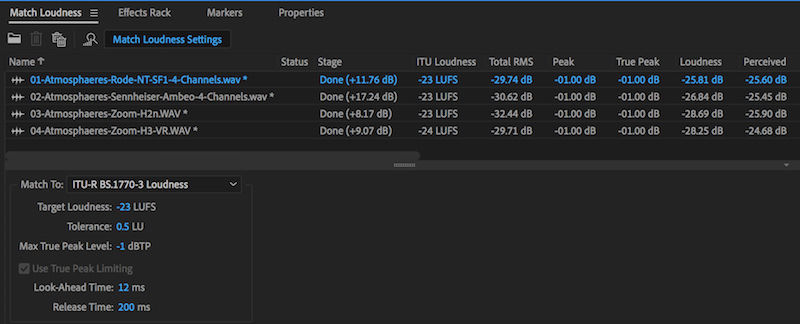
Spectrograms
Before we get to the sound recordings themselves, let’s take a look at the spectrograms of each of the loudness matched recordings.
First up, this is an overview of the entire recording (of the Røde NT-SF1). You can clearly see the quiet area from around 2:35 to 2:50. This is the area that I was most interested in.
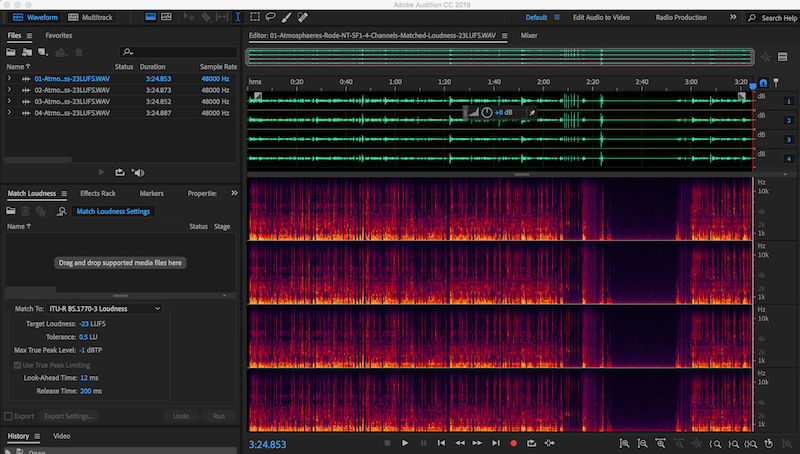
The next screenshot shows you this 2:35-2:50 area zoomed in on the Røde NT-SF1. Click on the screenshot for a higher resolution image or click on the button below the screenshot to hear the entire recording. You can also download the recordings from all microphones further down so you can load them into your own DAW and zoom into the silence area.
Røde NT-SF1
Listen to the Røde NT-SF1 Self-Noise
Sennheiser Ambeo VR Mic
Listen to the Sennheiser Ambeo VR Mic Self-Noise
Zoom H2n
Listen to the Zoom H2n Self-Noise
Zoom H3-VR
Listen to the Zoom H3-VR Self-Noise
Our Results
While spectrograms don’t give us the full story, they are already very clear when it comes to the H3-VR and H2n. The self-noise of the H3-VR is a lot less than that of the H2n, which you will also hear when you listen to the recordings. So the H3-VR is certainly going to be our go-to solution for recordings where we need a quick setup. Again, I’m not going to talk about all the other new features (e.g. true ambisonic recording, automatic orientation recognition, etc) in detail here but the H3-VR clearly is a winner and will replace the H2n in our equipment bag.
Of course, our bigger interest was for the NT-SF1, which we are going to use in quieter locations where we have more time for setup. After this test, I can clearly say that I prefer the NT-SF1 a lot over the Ambeo VR Mic. I believe that the self-noise of the NT-SF1 is a tiny bit lower than that of the Ambeo, although, this would not necessarily be the only deciding factor because the difference is so small that it is almost not worth arguing about. But even if both mics would exhibit the same self-noise, the NT-SF1 is absolutely the better microphone for the simple reason that it is a whole €500 or so cheaper than the Ambeo and that is not even counting the popshield/blimp and windjammer that are included with the NT-SF1 package and that you have to purchase in addition to the Ambeo. At this price point, the Røde NT-SF1 is a clear winner and my new favourite spatial audio microphone, especially in combination with the Zoom F8, which is a perfect match for spatial audio microphones.
Further Analysis
Angelo Farina, a member of our Facebook Spatial Audio in VR/AR/MR group took the recordings and performed some additional analyses of both, the loudness-matched as well as the original recordings. Below are the graphs from these analyses. Please note that I am a nature sound recordist and not a sound researcher, so any questions about these graphs should be directed to Angelo Farina.
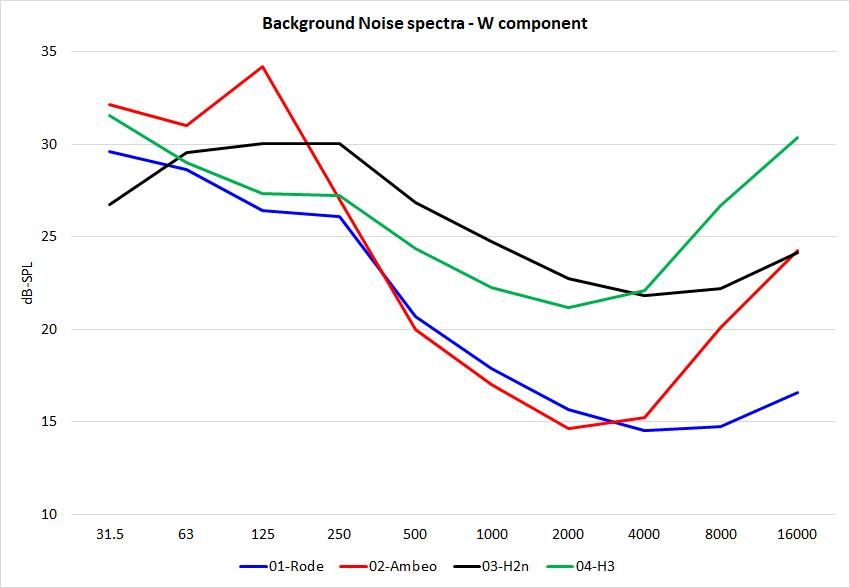
The values to dB SPL in octave bands, plus total A, weighted for channel W in the above graph are
1 – Rode NT-SF1: 25.96 dB(A)
2 – Sennheiser Ambeo: 27.88 dB(A)
3 – Zoom H2n: 32.41 dB(A)
4 – Zoom H3-VR: 33.16 dB(A)
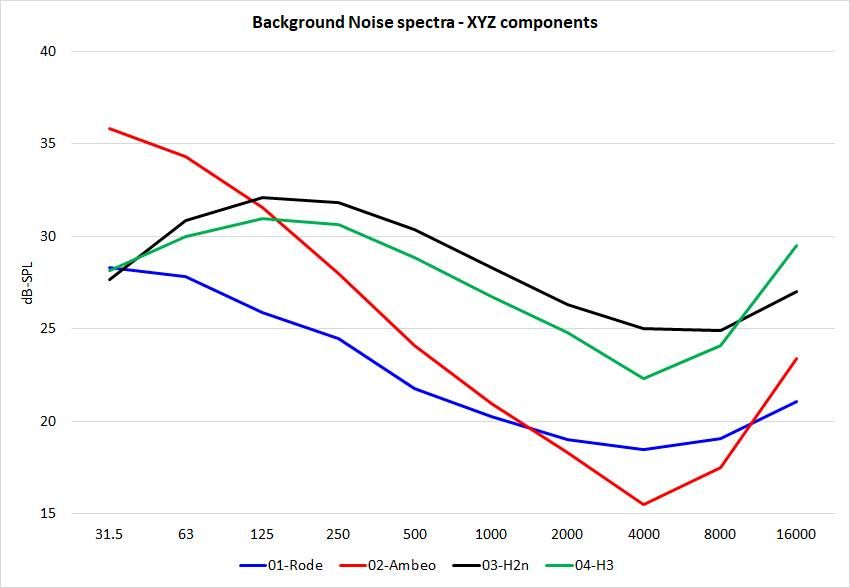
The results for the velocity channels XYZ in the above analysis and graph
1 – Rode NT-SF1: 28.42 dB(A)
2 – Sennheiser Ambeo: 29.09 dB(A)
3 – Zoom H2n: 35.64 dB(A)
4 – Zoom H3-VR: 34.54 dB(A)
Downloads
Below are the original, unaltered recordings. The silence area is between 2:25 and 2:50
File 00 contains the NT-SF1 AND Ambeo recordings on channels 1-8. Channels 1-4 are the NT-SF1, Channels 5-8 are the Ambeo.
File 01 are channels 1-4 (NT-SF1) extracted (A-Format)
File 02 are channels 5-8 (Ambeo) extracted (A-Format)
File 03 is the H2n in spatial audio setting (B-Format)
File 04 is the H3-VR in spatial audio setting (A-Format, inverted/upside-down)
Download Original, Unaltered Wav Files (Zip)
The following download contains the full-length recordings after loudness matching has been applied.
Download -23 LUFS Loudness-Matched Wav Files (Zip)
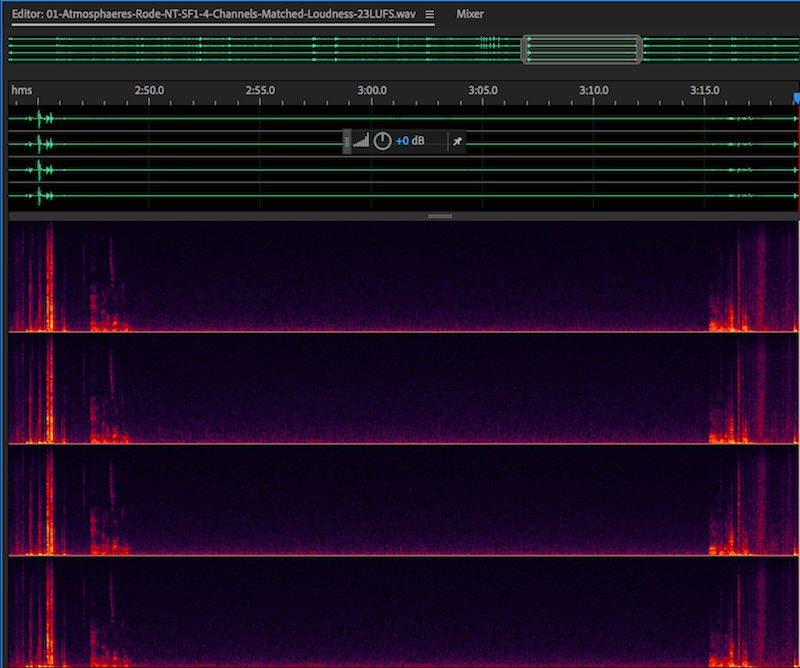
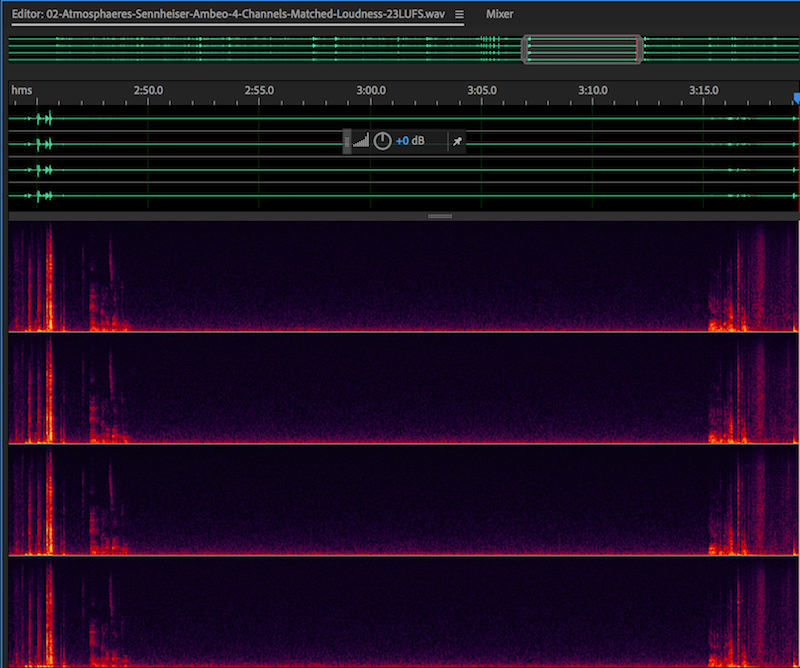
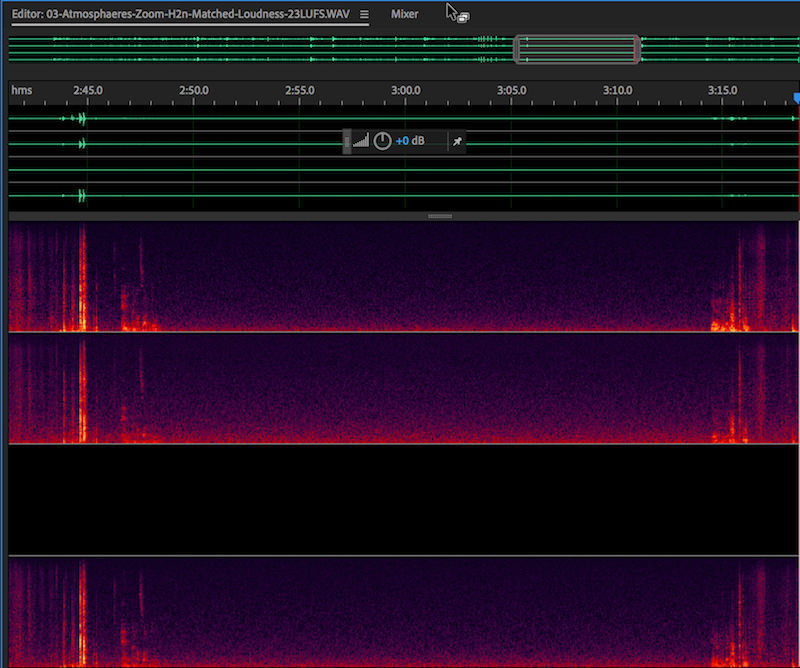
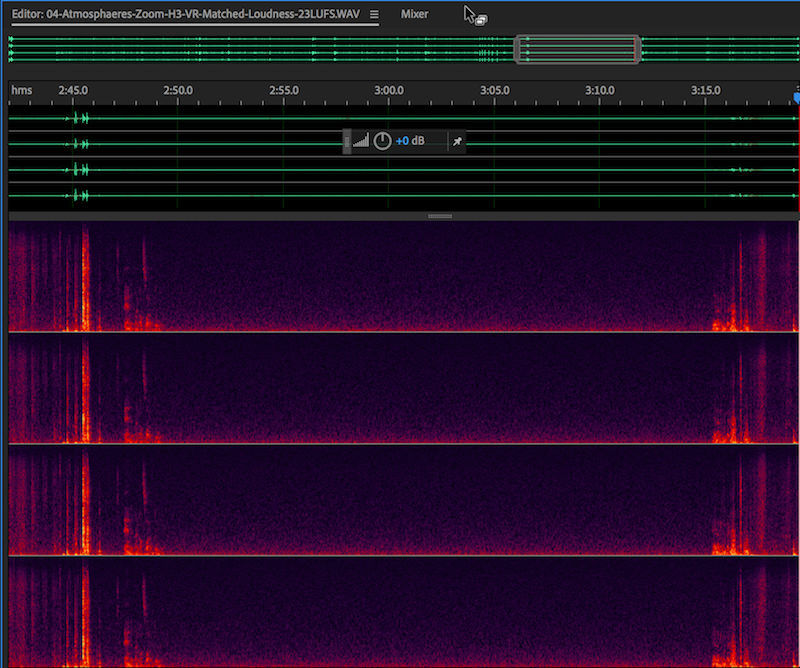
 RSS - Posts
RSS - Posts
Angelo Farina
Great work, very interesting!
I am trying to reprocess your recordings for getting more explicit data.
There is some information missing in your report, can you fill it up?
1) What were the exact gain settings for each of the microphones, and particularly for the gains on the Zoom F8?
2) Which recording is A-format and which is B-format? I understand that the the H2N was in B-format mode, (as channel 3, Z, is silent), and the Rode and Ambeo look like A-format. But I do not understand if the H3 was set for recording A-format or B-format.
3) Can you make available the original recordings (not rescaled)?
4) Did you measure the spectrum of the background noise in the room with a sound level meter equipped with 1/3 octave band analysis?
Thanks!
Eric Fassbender
Hi Angelo, I have updated the page with the original recordings and the info about gains and spatial audio format. I do not have a sound level meter, so sadly I cannot provide any information on this.
Rebecca
Hi Angelo, I found your comment and am very interested in your analysis, as I have to compare the H2n and the H3-VR for a scientific paper in uni. Can you maybe tell me more about how you conducted the analysis and which settings you chose to make them really objectively comparable? Did you also match the loudness? what was your process and what software did you use? If possible, can you explain that step by step? I would be forever grateful!
AJF van Halderen
Interessting , but i would use a microphone to record sound or music – and not its own selfnoise. How does the Rode and sennheiser compare on this aspect (sound / music) ?
Eric Fassbender
We record mostly nature sounds which are sometimes very low in volume, so self-noise of microphones and recorders is a very important criterion for us. If you are more interested in recording music then the self-noise is much less important because it will be masked by the sound that is a lot louder than the self-noise of the microphones. So when you are recording music both microphones will give you a similar result.
Dan
Hi, there is a problem with the download of the samples it doesen’t works. It ask where to save but then it gives an error.
Please try: https://www.atmosphaeres.com/blog/spatial-audio-microphones-self-noise-comparison-4-mics/
I would be really grateful if you let me know, thx a lot
Dan
Eric Fassbender
Hi Dan, thanks for the heads up and sorry for the inconvenience. The downloads should be fixed, now. Please let me know if you encounter any more troubles!
Cheers, Eric
Andreas
Interesting comparison. Beside the fact, that the AMBEO has a lot more Self Noise (17dBA) vs the SF1 (13dBA). The Selfnoise feels quite even, while listening to it.
In my opinion, the AMBEO reveals much more detail and the Selfnoise is much more even (pleasing) in its sound quality, while the SF1 feels a bit technical or uneven. It sounds crackling and unnatural.
I also can hear the humming of whatever it is in the background which is not audible in the SF1 recording.
Anyways. Thanks for your Test. I highly appreciate the effort ☺️✌🏻
Marco
I noticed the deep Humm in the Ambeo. I wonder if that humm is something like a “self-humm” or it was a humm present in the room that the Rode was not able to pick up.
Carlo Sánchez
The samples are very interesting. Thanks for all.
Finally with anyone we will have to apply noise cleaning in quiet environments,
now this is not a problem if you project goes through a process sound post production.
S Wilson
The self-noise comparison of the Ambeo and NT-SF1 is exactly what I am interested in, thank you for taking the time to post this. It would be interesting to hear a voice or a sound in the middle of a silence so we can hear that the recording level of the microphones is the same. The spectogram of the Sennheiser recording looks to be peaking lower to my eye?
Robin Parmar
I would simply like to thank you for the time taken to conduct this test. Self-noise is often ignored in reviews, perhaps because it’s not as important to the reviewer. This article fills an important gap.
Eric Fassbender
Hi Robin, thanks for your kind words. I’m glad if my articles helps in finding the right tool for the job 🙂
Xander Black
Hi, this is an old post but still quite valuable. Do you have any thoughts on the VRH-8 attachment in comparison to the H3VR? is that something that would be worth testing for you? Thanks.
Eric Fassbender
Hi Xander, I’ve looked at the VRH-8 and to me, it looks very much like the H3-VR with just a connection option instead of a built-in recorder. I don’t know if the sound quality is any different and haven’t looked into the specs deeper to know whether they have different capsules or electronics. A comparison would be interesting, however, we’re quite happy with the results that we get from the H3-VR and the Rode NT-SF1/Zoom F8 combo that we have, so we have no need for another mic/recorder at the moment. At least not until an affordable field recorder (the SoundDevices 888 is around €10K!) comes out that records 2nd order spatial audio via Dante or a similar one-cable interface.